TESLA ROADSTER 2008 Owners Manual
Manufacturer: TESLA, Model Year: 2008, Model line: ROADSTER, Model: TESLA ROADSTER 2008Pages: 115, PDF Size: 46.35 MB
Page 101 of 115
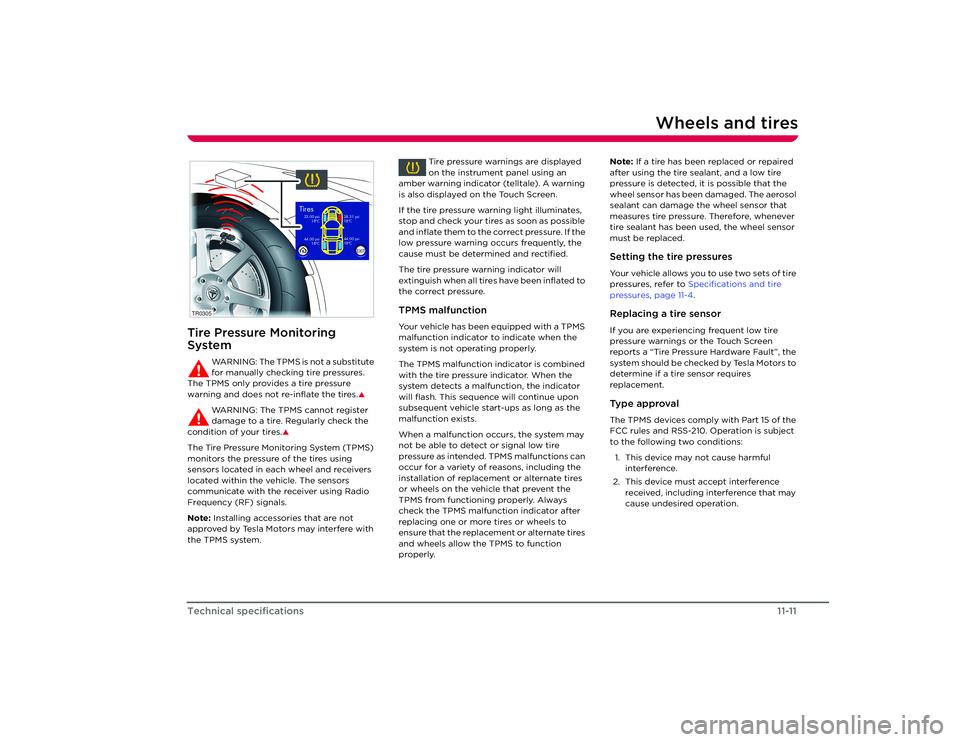
Wheels and tires
11-11
Technical specifications
Tire Pressure Monitoring
System
WARNING: The TPMS is not a substitute
for manually checking tire pressures.
The TPMS only provides a tire pressure
warning and does not re-inflate the tires.
�S
WARNING: The TPMS cannot register
damage to a tire. Regularly check the
condition of your tires.
�S
The Tire Pressure Monitoring System (TPMS)
monitors the pressure of the tires using
sensors located in each wheel and receivers
located within the vehicle. The sensors
communicate with the receiver using Radio
Frequency (RF) signals.
Note: Installing accessories that are not
approved by Tesla Motors may interfere with
the TPMS system. Tire pressure warnings are displayed
on the instrument panel using an
amber warning indicator (telltale). A warning
is also displayed on the Touch Screen.
If the tire pressure warning light illuminates,
stop and check your tires as soon as possible
and inflate them to the correct pressure. If the
low pressure warning occurs frequently, the
cause must be determined and rectified.
The tire pressure warning indicator will
extinguish when all tires have been inflated to
the correct pressure.
TPMS malfunctionYour vehicle has been equipped with a TPMS
malfunction indicator to indicate when the
system is not operating properly.
The TPMS malfunction indicator is combined
with the tire pressure indicator. When the
system detects a malfunction, the indicator
will flash. This sequence will continue upon
subsequent vehicle start-ups as long as the
malfunction exists.
When a malfunction occurs, the system may
not be able to detect or signal low tire
pressure as intended. TPMS malfunctions can
occur for a variety of reasons, including the
installation of replacement or alternate tires
or wheels on the vehicle that prevent the
TPMS from functioning properly. Always
check the TPMS malfunction indicator after
replacing one or more tires or wheels to
ensure that the replacement or alternate tires
and wheels allow the TPMS to function
properly. Note:
If a tire has been replaced or repaired
after using the tire sealant, and a low tire
pressure is detected, it is possible that the
wheel sensor has been damaged. The aerosol
sealant can damage the wheel sensor that
measures tire pressure. Therefore, whenever
tire sealant has been used, the wheel sensor
must be replaced.
Setting the tire pressuresYour vehicle allows you to use two sets of tire
pressures, refer to Specifications and tire
pressures, page 11-4 .Replacing a tire sensorIf you are experiencing frequent low tire
pressure warnings or the Touch Screen
reports a “Tire Pressure Hardware Fault”, the
system should be checked by Tesla Motors to
determine if a tire sensor requires
replacement.Type approvalThe TPMS devices comply with Part 15 of the
FCC rules and RSS-210. Operation is subject
to the following two conditions:
1. This device may not cause harmful interference.
2. This device must accept interference received, including interference that may
cause undesired operation.
TR0305
44.00 psi 18 Co33.00 psi18 Co
28.31 psi
18 Co44.00 psi
18 Co
Tires
EXIT
Roadster OHB.book Page 11 Thursday, October 2, 2008 8:59 AM
Page 102 of 115
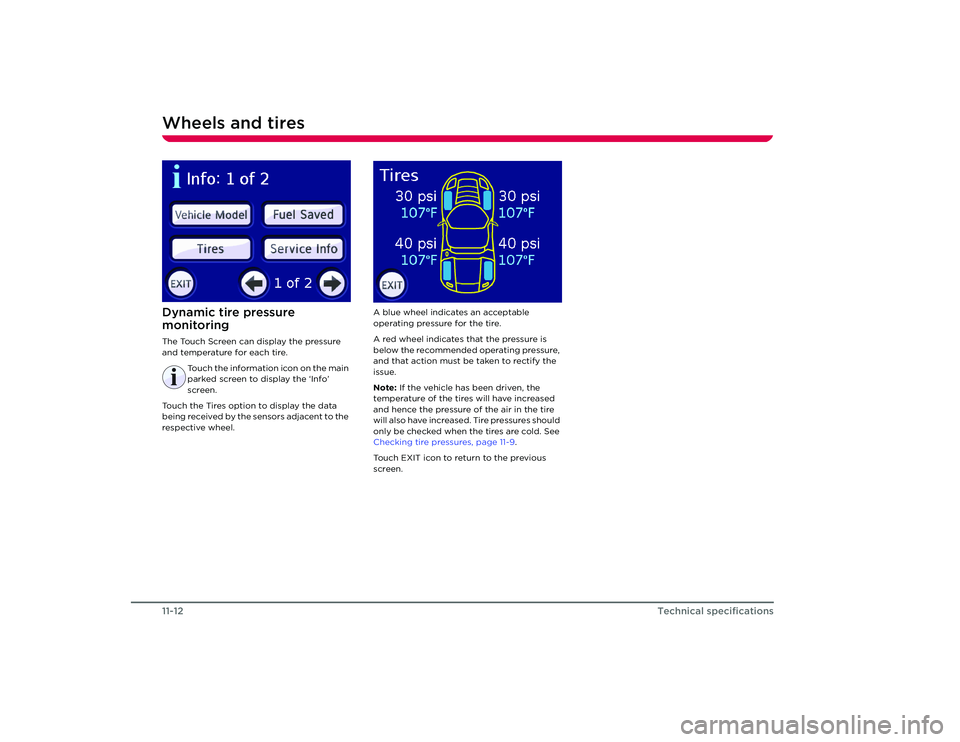
Wheels and tires11-12
Technical specifications
Dynamic tire pressure
monitoringThe Touch Screen can display the pressure
and temperature for each tire.Touch the information icon on the main
parked screen to display the ‘Info’
screen.
Touch the Tires option to display the data
being received by the sensors adjacent to the
respective wheel. A blue wheel indicates an acceptable
operating pressure for the tire.
A red wheel indicates that the pressure is
below the recommended operating pressure,
and that action must be taken to rectify the
issue.
Note:
If the vehicle has been driven, the
temperature of the tires will have increased
and hence the pressure of the air in the tire
will also have increased. Tire pressures should
only be checked when the tires are cold. See
Checking tire pressures, page 11-9 .
Touch EXIT icon to return to the previous
screen. iRoadster OHB.book Page 12 Thursday, October 2, 2008 8:59 AM
Page 103 of 115

Wheels and tires
11-13
Technical specifications
Wheels and tires glossaryAccessory weightThe combined weight (in excess of those
items replaced) of items available as factory
installed equipment.BeadThe inner edge of a tire that is shaped to fit to
the rim and form an air tight seal. The bead is
constructed of steel wires which are
wrapped, or reinforced, by the ply cords.Cold tire pressureThe air pressure in a tire which has been
standing in excess of three hours, or driven
for less than one mile.Curb weightThe weight of a standard vehicle, including
any optional equipment fitted, and with the
correct fluid levels.Gross vehicle weightThe maximum permissible weight of a vehicle
with driver, passengers, load, luggage, and
equipment.kPa (kilo pascal)A metric unit used to measure pressure. One
kilo pascal equals approximately .145 psi.Maximum inflation pressureThe maximum pressure to which the tire
should be inflated. This pressure is given on
the tire side wall in lbf/in
2. Note: This pressure is the maximum allowed
by the tire manufacturer. It is not the pressure
recommended for use.
Maximum loaded vehicle weightThe sum of curb weight, accessory weight,
vehicle capacity weight, and production
options weight.Production options weightThe combined weight of options installed
which weigh in excess of 3 lb more than the
standard items that they replaced, and are
not already considered in curb or accessory
weights. PSI (lbf/in
2)
Pounds per square inch, unit of measure for
pressure.RimThe metal support for a tire, or tire and tube,
upon which the tire beads are seated.Vehicle capacity weightThe number of seats multiplied by 150 lb plus
the rated amount of load/luggage.
Roadster OHB.book Page 13 Thursday, October 2, 2008 8:59 AM
Page 104 of 115
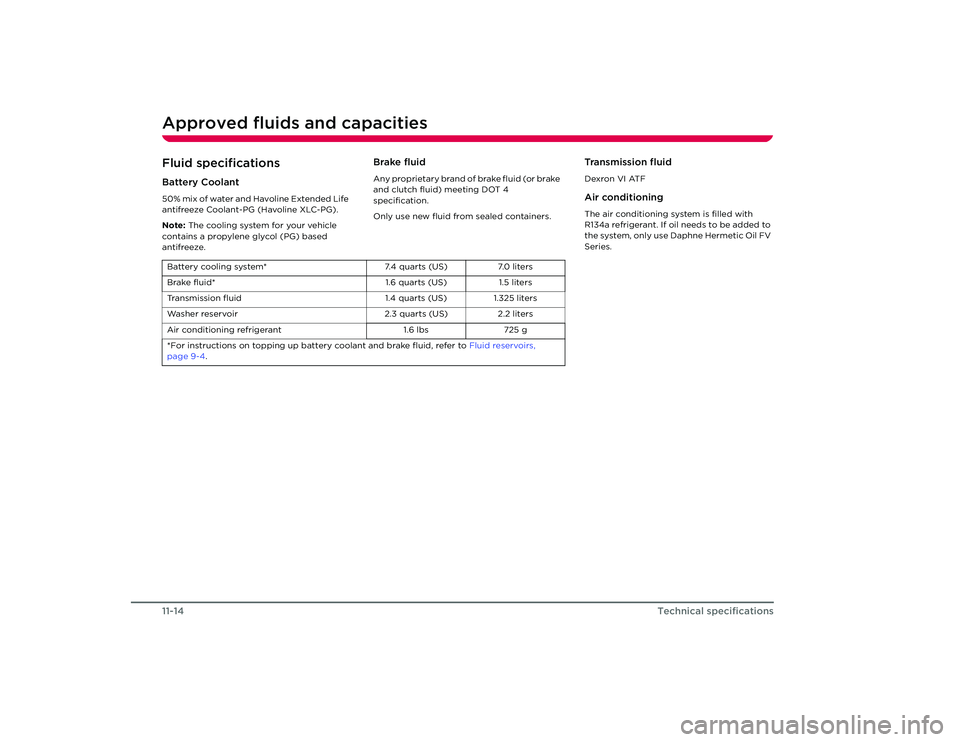
Approved fluids and capacities11-14
Technical specifications
Approved fluids and capacitiesFluid specificationsBattery Coolant50% mix of water and Havoline Extended Life
antifreeze Coolant-PG (Havoline XLC-PG).
Note: The cooling system for your vehicle
contains a propylene glycol (PG) based
antifreeze.
Brake fluidAny proprietary brand of brake fluid (or brake
and clutch fluid) meeting DOT 4
specification.
Only use new fluid from sealed containers.
Transmission fluidDexron VI ATFAir conditioningThe air conditioning system is filled with
R134a refrigerant. If oil needs to be added to
the system, only use Daphne Hermetic Oil FV
Series.
Battery cooling system* 7.4 quarts (US)7.0 liters
Brake fluid* 1.6 quarts (US)1.5 liters
Transmission fluid 1.4 quarts (US)1.325 liters
Washer reservoir 2.3 quarts (US)2.2 liters
Air conditioning refrigerant 1.6 lbs725 g
*For instructions on topping up batt ery coolant and brake fluid, refer to Fluid reservoirs,
page 9-4 .
Roadster OHB.book Page 14 Thursday, October 2, 2008 8:59 AM
Page 105 of 115
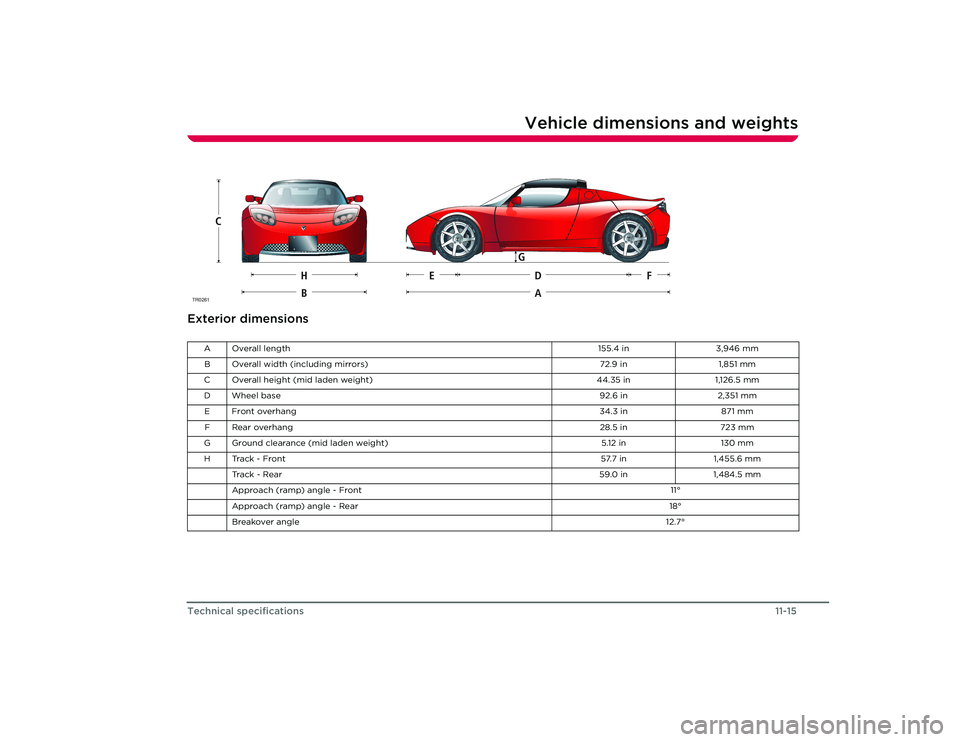
Vehicle dimensions and weights
11-15
Technical specifications
Vehicle dimensions and weightsExterior dimensionsTR0261
HED G
F
C
BA
A Overall length 155.4 in3,946 mm
B Overall width (including mirrors) 72.9 in1,851 mm
C Overall height (mid laden weight) 44.35 in1,126.5 mm
D Wheel base 92.6 in2,351 mm
E Front overhang 34.3 in871 mm
F Rear overhang 28.5 in723 mm
G Ground clearance (mid laden weight) 5.12 in130 mm
HTrack - Front 57.7 in1,455.6 mm
Track - Rear 59.0 in1,484.5 mm
Approach (ramp) angle - Front 11°
Approach (ramp) angle - Rear 18°
Breakover angle 12.7°
Roadster OHB.book Page 15 Thursday, October 2, 2008 8:59 AM
Page 106 of 115
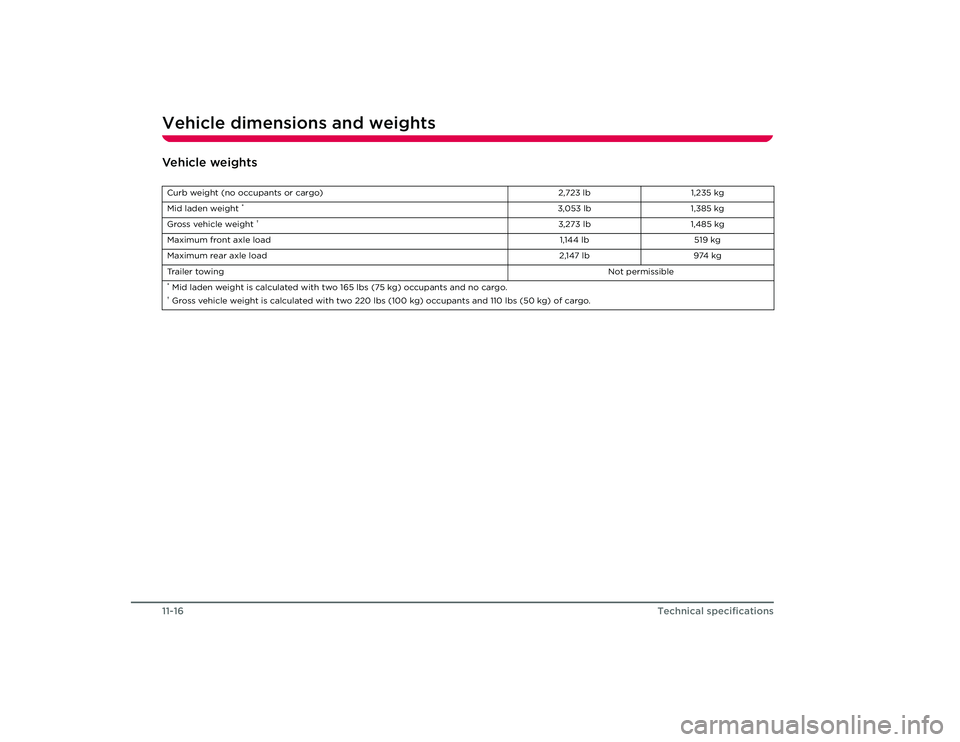
Vehicle dimensions and weights11-16
Technical specifications
Vehicle weightsCurb weight (no occupants or cargo)2,723 lb1,235 kg
Mid laden weight
*
3,053 lb 1,385 kg
Gross vehicle weight
†
3,273 lb 1,485 kg
Maximum front axle load 1,144 lb519 kg
Maximum rear axle load 2,147 lb974 kg
Tr a i l e r t o w i n g Not permissible
* Mid laden weight is calculated with two 165 lbs (75 kg) occupants and no cargo.† Gross vehicle weight is calculated with two 220 lbs (100 kg) occupants and 110 lbs (50 kg) of cargo.Roadster OHB.book Page 16 Thursday, October 2, 2008 8:59 AM
Page 107 of 115
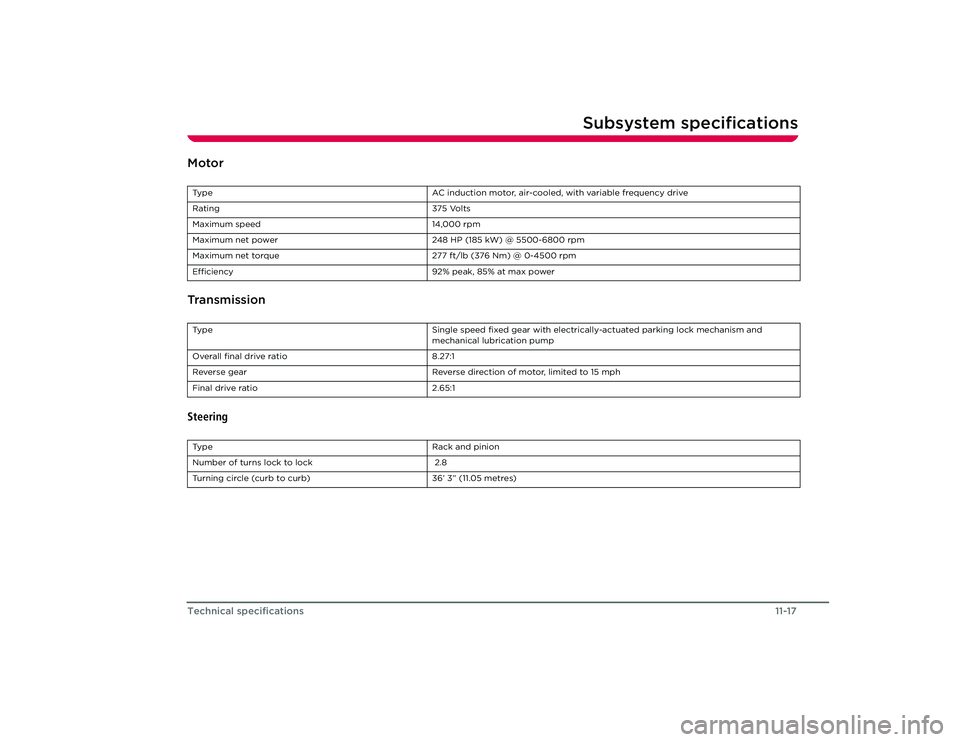
Subsystem specifications
11-17
Technical specifications
Subsystem specificationsMotor
TransmissionSteeringType AC induction motor, air-cooled, with variable frequency drive
Rating 375 Volts
Maximum speed 14,000 rpm
Maximum net power 248 HP (185 kW) @ 5500-6800 rpm
Maximum net torque 277 ft/lb (376 Nm) @ 0-4500 rpm
Efficiency 92% peak, 85% at max powerType Single speed fixed gear with electrically-actuated parking lock mechanism and
mechanical lubrication pump
Overall final drive ratio 8.27:1
Reverse gear Reverse direction of motor, limited to 15 mph
Final drive ratio 2.65:1TypeRack and pinion
Number of turns lock to lock 2.8
Turning circle (curb to curb) 36’ 3” (11.05 metres)
Roadster OHB.book Page 17 Thursday, October 2, 2008 8:59 AM
Page 108 of 115
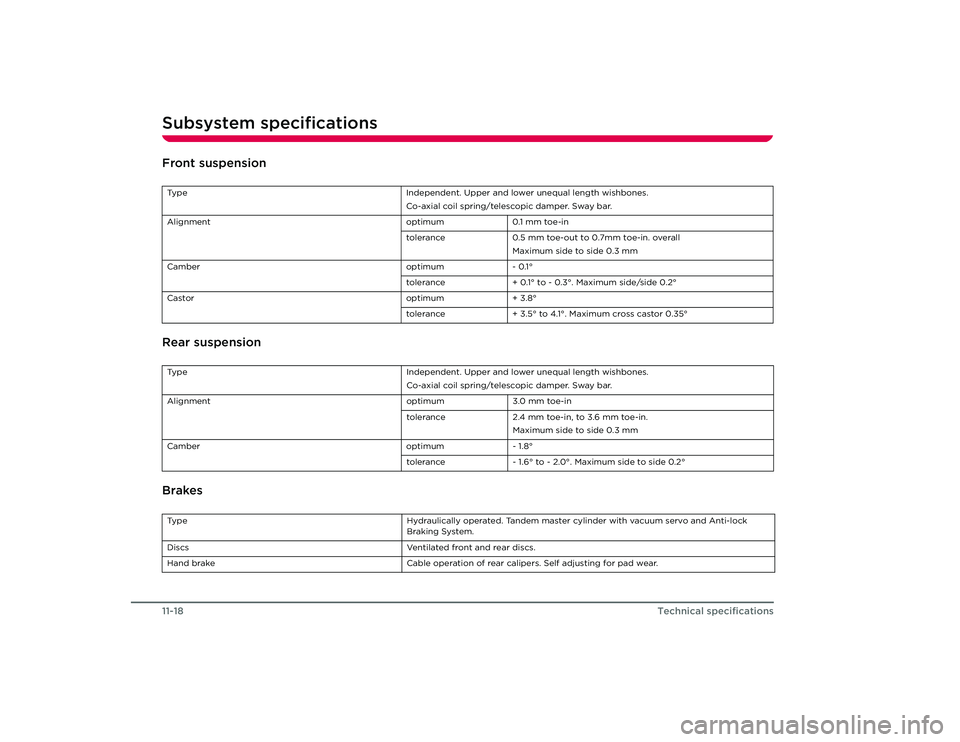
Subsystem specifications11-18
Technical specifications
Front suspension
Rear suspension
BrakesTypeIndependent. Upper and lower unequal length wishbones.
Co-axial coil spring/telescopic damper. Sway bar.
Alignment optimum0.1 mm toe-in
tolerance 0.5 mm toe-out to 0.7mm toe-in. overall
Maximum side to side 0.3 mm
Camber optimum- 0.1°
tolerance + 0.1° to - 0.3°. Maximum side/side 0.2°
Castor optimum+ 3.8°
tolerance + 3.5° to 4.1°. Maximum cross castor 0.35°Type Independent. Upper and lower unequal length wishbones.
Co-axial coil spring/telescopic damper. Sway bar.
Alignment optimum3.0 mm toe-in
tolerance 2.4 mm toe-in, to 3.6 mm toe-in.
Maximum side to side 0.3 mm
Camber optimum- 1.8°
tolerance - 1.6° to - 2.0°. Maximum side to side 0.2°Type Hydraulically operated. Tandem master cylinder with vacuum servo and Anti-lock
Braking System.
Discs Ventilated front and rear discs.
Hand brake Cable operation of rear calipers. Self adjusting for pad wear.Roadster OHB.book Page 18 Thursday, October 2, 2008 8:59 AM
Page 109 of 115
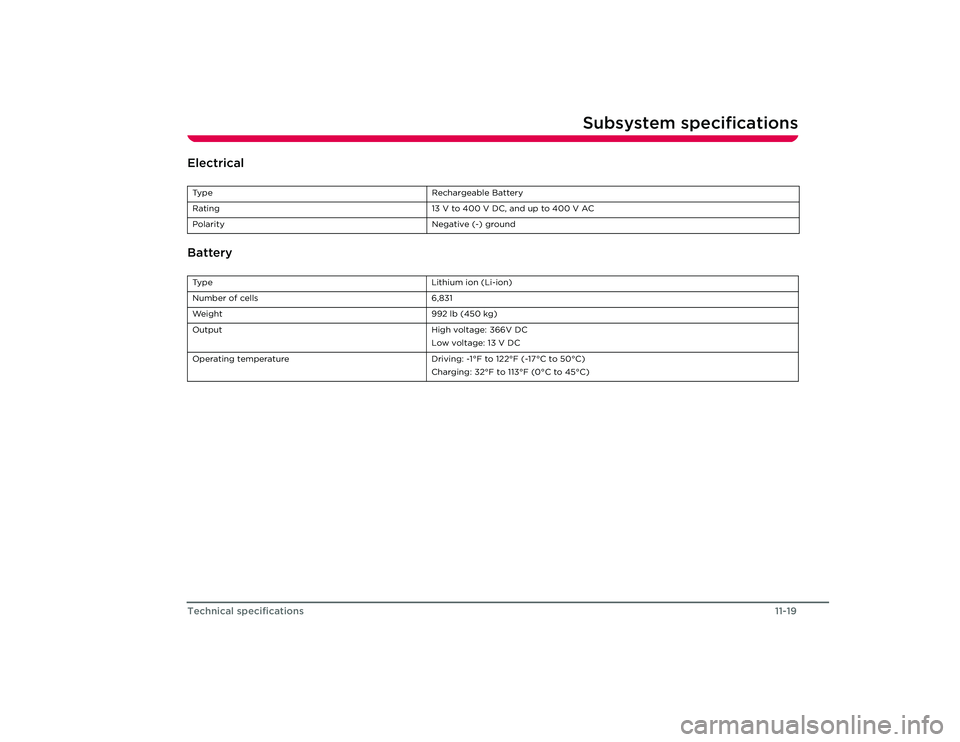
Subsystem specifications
11-19
Technical specifications
Electrical
BatteryTy p e R e c h a r g e a b l e B a t t e r y
Rating 13 V to 400 V DC, and up to 400 V AC
Polarity Negative (-) groundTypeLithium ion (Li-ion)
Number of cells 6,831
Weight 992 lb (450 kg)
Output High voltage: 366V DC
Low voltage: 13 V DC
Operating temperature Driving: -1°F to 122°F (-17°C to 50°C)
Charging: 32°F to 113°F (0°C to 45°C)
Roadster OHB.book Page 19 Thursday, October 2, 2008 8:59 AM
Page 110 of 115
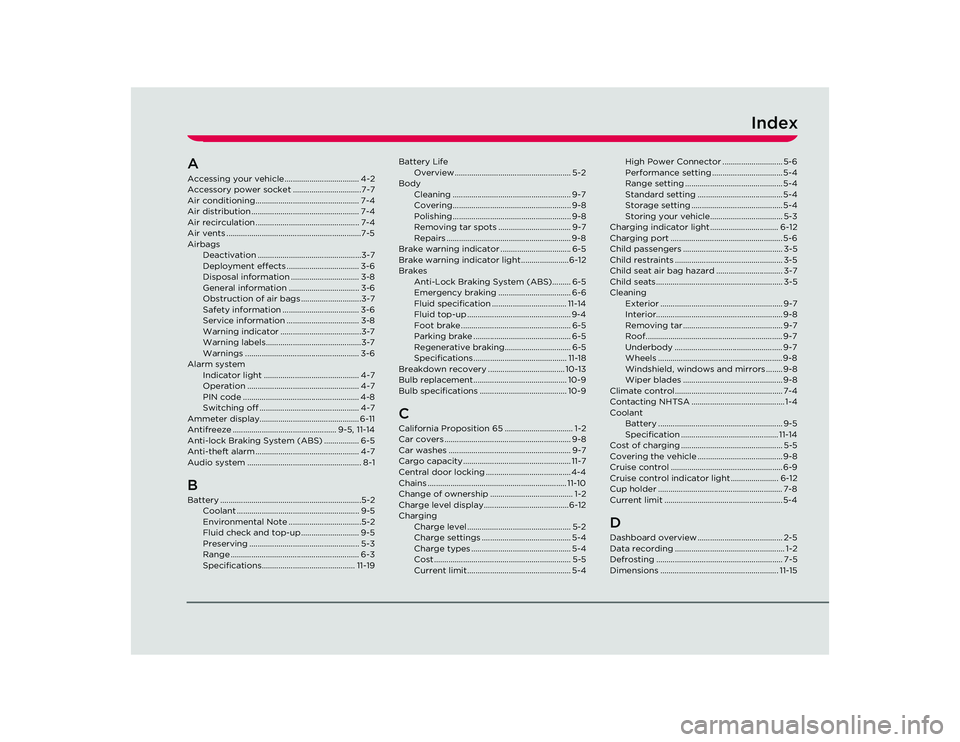
Index
AAccessing your vehicle.................................... 4-2
Accessory power socket .................................7-7
Air conditioning.................................................. 7-4
Air distribution .................................................... 7-4
Air recirculation .................................................. 7-4
Air vents .................................................................7-5
AirbagsDeactivation ..................................................3-7
Deployment effects ................................... 3-6
Disposal information ................................. 3-8
General information .................................. 3-6
Obstruction of air bags .............................3-7
Safety information ..................................... 3-6
Service information ................................... 3-8
Warning indicator .......................................3-7
Warning labels..............................................3-7
Warnings ....................................................... 3-6
Alarm system Indicator light .............................................. 4-7
Operation ...................................................... 4-7
PIN code ........................................................ 4-8
Switching off ................................................ 4-7
Ammeter display................................................ 6-11
Antifreeze .................................................. 9-5, 11-14
Anti-lock Braking System (ABS) ................. 6-5
Anti-theft alarm .................................................. 4-7
Audio system ....................................................... 8-1BBattery ....................................................................5-2 Coolant ........................................................... 9-5
Environmental Note ...................................5-2
Fluid check and top-up ............................ 9-5
Preserving ..................................................... 5-3
Range .............................................................. 6-3
Specifications............................................. 11-19 Battery Life
Overview ........................................................ 5-2
Body Cleaning ......................................................... 9-7
Covering......................................................... 9-8
Polishing ......................................................... 9-8
Removing tar spots ................................... 9-7
Repairs ............................................................ 9-8
Brake warning indicator .................................. 6-5
Brake warning indicator light .......................6-12
Brakes Anti-Lock Braking System (ABS)......... 6-5
Emergency braking ................................... 6-6
Fluid specification .................................... 11-14
Fluid top-up .................................................. 9-4
Foot brake ..................................................... 6-5
Parking brake ............................................... 6-5
Regenerative braking................................ 6-5
Specifications ............................................. 11-18
Breakdown recovery ..................................... 10-13
Bulb replacement............................................. 10-9
Bulb specifications .......................................... 10-9
CCalifornia Proposition 65 ................................. 1-2
Car covers ............................................................. 9-8
Car washes ........................................................... 9-7
Cargo capacity.................................................... 11-7
Central door locking ......................................... 4-4
Chains ................................................................... 11-10
Change of ownership ........................................ 1-2
Charge level display.........................................6-12
Charging Charge level .................................................. 5-2
Charge settings ........................................... 5-4
Charge types ................................................ 5-4
Cost .................................................................. 5-5
Current limit.................................................. 5-4 High Power Connector ............................. 5-6
Performance setting .................................. 5-4
Range setting ............................................... 5-4
Standard setting ......................................... 5-4
Storage setting ............................................ 5-4
Storing your vehicle................................... 5-3
Charging indicator light ................................. 6-12
Charging port ...................................................... 5-6
Child passengers ................................................ 3-5
Child restraints .................................................... 3-5
Child seat air bag hazard ................................ 3-7
Child seats............................................................. 3-5
Cleaning Exterior ........................................................... 9-7
Interior............................................................. 9-8
Removing tar ................................................ 9-7
Roof.................................................................. 9-7
Underbody .................................................... 9-7
Wheels ............................................................ 9-8
Windshield, windows and mirrors ........ 9-8
Wiper blades ................................................ 9-8
Climate control.................................................... 7-4
Contacting NHTSA ............................................. 1-4
Coolant Battery ............................................................ 9-5
Specification ............................................... 11-14
Cost of charging ................................................. 5-5
Covering the vehicle ......................................... 9-8
Cruise control ...................................................... 6-9
Cruise control indicator lig ht ....................... 6-12
Cup holder ............................................................ 7-8
Current limit ......................................................... 5-4
DDashboard overview ......................................... 2-5
Data recording ..................................................... 1-2
Defrosting ............................................................. 7-5
Dimensions ......................................................... 11-15
Roadster OHB.book Page 1 Th ursday, October 2, 2008 8:59 AM